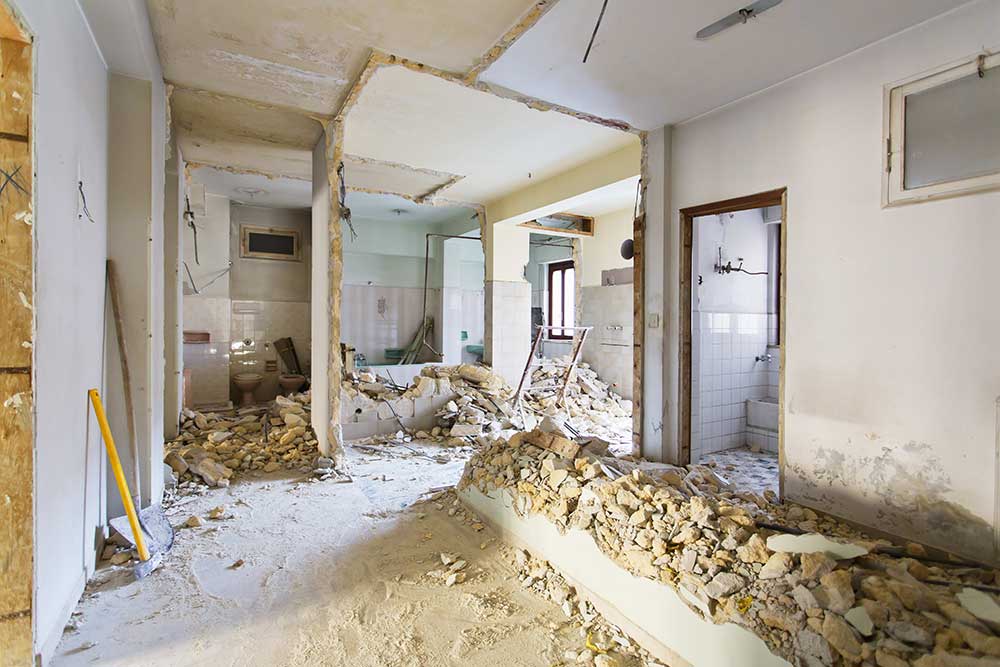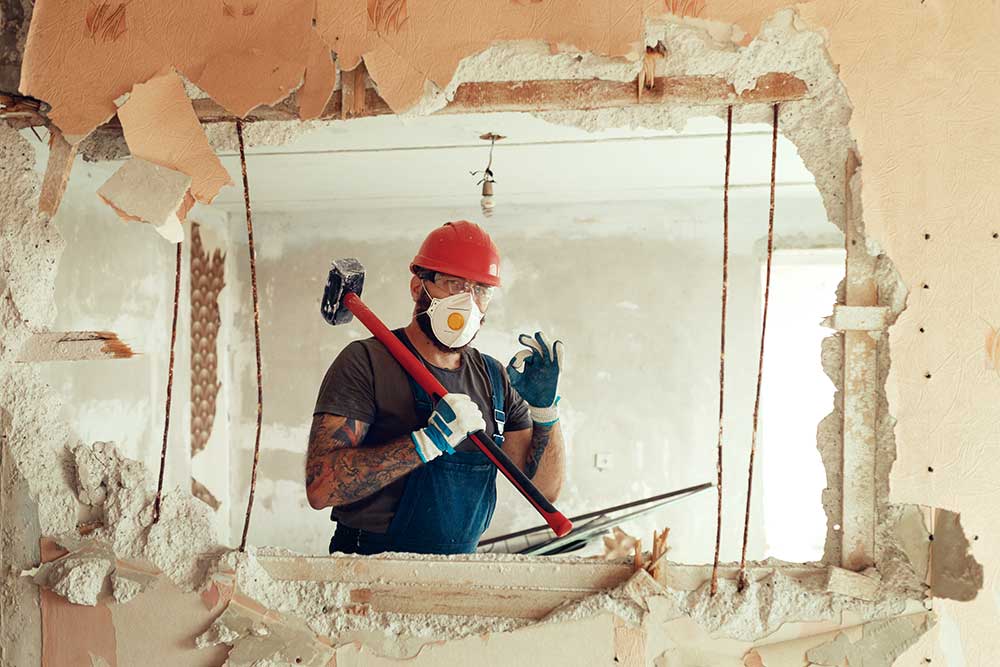Demolition jobs involve the dismantling, removal, or destruction of structures or buildings. Performing a demolition job safely and efficiently requires careful planning, adherence to regulations, and consideration of various factors. Here are some important factors to consider when doing a demolition job:

- Safety Precautions: Safety is paramount in demolition work. Conduct a thorough risk assessment to identify potential hazards, implement safety protocols, provide proper personal protective equipment (PPE) for workers, and ensure all team members are adequately trained in demolition procedures.
- Site Evaluation: Assess the site and structure to be demolished. Identify any structural weaknesses, hazardous materials (e.g., asbestos, lead, chemicals), nearby utilities, and potential environmental impacts. This evaluation helps in developing an appropriate demolition strategy.
- Permits and Regulations: Obtain all necessary permits and comply with local, state, and federal regulations governing demolition activities. Failure to acquire the required permits could result in fines or other legal consequences.
- Method of Demolition: Choose the most suitable demolition method based on the structure’s type, size, location, and condition. Methods may include mechanical demolition, implosion (controlled explosives), selective dismantling, or deconstruction.
- Environmental Considerations: Implement measures to mitigate environmental impacts, such as dust control, water runoff management, waste disposal, and proper handling of hazardous materials.
- Utilities Disconnection: Ensure all utilities (water, gas, electricity) are safely disconnected before starting demolition work to prevent accidents and damage to infrastructure.
- Structural Stability: Plan the demolition process to maintain the stability of adjacent structures and ensure that the demolition doesn’t cause unintended collapses or damages.
- Public Safety: Consider the safety of the surrounding area and nearby residents. Implement safety barriers, warning signs, and traffic control measures to protect the public during the demolition process.
- Waste Management: Develop a waste management plan to handle debris and materials resulting from the demolition. Consider recycling and responsible disposal practices.
- Equipment and Tools: Use appropriate equipment and tools for the demolition job, ensuring they are in good working condition and operated by trained personnel.
- Sequence of Demolition: Establish a demolition sequence to systematically bring down the structure without compromising safety or causing excessive debris buildup.
- Project Timeline: Set a realistic timeline for the demolition project, taking into account the complexities of the structure and any potential delays.
- Communication and Coordination: Maintain clear communication and coordination among all team members involved in the demolition job to ensure a smooth and safe process.
- Emergency Response Plan: Have a comprehensive emergency response plan in place to handle unforeseen situations or accidents that may occur during the demolition.
- Documentation and Records: Keep detailed records of the demolition process, including permits, safety protocols, inspections, and any incidents that occur.
By carefully considering these factors and taking a well-planned approach to demolition work, contractors can execute the job efficiently while prioritizing the safety of workers, the public, and the environment.
Why Demolish A Building?

Demolition is necessary for various reasons, and it serves several essential purposes:
- Obsolete Structures: Buildings and structures can become obsolete due to changing needs, advancements in technology, or changes in regulations. Demolition allows for the removal of outdated and non-functional structures to make way for new developments.
- Safety and Structural Integrity: Some buildings may deteriorate over time or suffer damage from natural disasters, fire, or other incidents, compromising their structural integrity. Demolition becomes necessary to eliminate potential hazards and ensure public safety.
- Urban Renewal and Redevelopment: In urban areas, demolition is often a crucial step in urban renewal and redevelopment projects. Removing old or blighted structures creates space for new, modern developments that can revitalize communities.
- Land Reclamation: Demolition of existing structures can be essential for land reclamation projects, such as clearing industrial sites for environmental remediation or converting brownfields into usable land.
- Infrastructure Development: In some cases, existing structures need to be demolished to make way for the construction of new infrastructure, such as roads, bridges, and public utilities.
- Building Repurposing: Occasionally, a building may be repurposed for a different use, requiring selective demolition to modify or remove specific sections while preserving essential elements.
- Expansion and Reconstruction: When a property needs expansion or reconstruction, demolition may be necessary to clear the area and make space for the new additions.
- Emergency Situations: In emergency situations where a building poses an immediate danger to life or property, urgent demolition might be required to prevent further risks.
- Environmental and Safety Concerns: In cases where a structure contains hazardous materials, such as asbestos or lead, demolition is necessary to safely remove and dispose of these materials.
- Legal and Regulatory Requirements: Some properties may be subject to legal orders for demolition due to violations of building codes, zoning regulations, or court orders.
- Public Infrastructure Projects: Demolition can be part of larger public infrastructure projects, such as road widening, airport expansions, or the construction of public buildings.
While demolition is necessary for these reasons, it is essential to ensure that the process is conducted safely, with proper planning, adherence to regulations, and consideration of environmental and community impacts. Proper waste management and recycling practices can also help reduce the environmental impact of demolition projects.
Demolition FAQ
Demolition is the process of dismantling, destroying, or removing a building, structure, or infrastructure to make way for new developments, address safety concerns, or clear land for other purposes.
Demolition methods include mechanical demolition (using equipment like excavators and bulldozers), implosion (controlled explosives), deconstruction (careful dismantling to salvage materials), and selective demolition (targeted removal of specific components).
Safety is paramount in demolition. Safety measures include conducting risk assessments, providing proper PPE for workers, implementing safety barriers, securing the site, and ensuring the structural stability of adjacent buildings.
Yes, most demolition projects require permits and must comply with local, state, and federal regulations. These regulations ensure safety, environmental protection, and proper waste disposal.
Yes, hazardous materials like asbestos, lead-based paint, and other chemicals might be present in older buildings. Proper testing and handling are essential to ensure worker and environmental safety.
The duration of a demolition project varies based on the size and complexity of the structure, the chosen demolition method, and any unforeseen challenges that may arise. It can take anywhere from a few days to several weeks.
Debris and waste are typically hauled to recycling centers or landfills. In some cases, materials like metal, concrete, and wood can be salvaged and recycled.
Yes, environmentally friendly demolition practices, such as deconstruction to salvage reusable materials, recycling, and responsible waste management, can minimize the environmental impact of demolition.
Yes, selective demolition or deconstruction allows for the targeted removal of specific parts of a structure, preserving materials for reuse or recycling.
The cost of demolition is influenced by factors like the size and type of structure, the chosen demolition method, site accessibility, hazardous material removal, and waste disposal fees.
Yes, careful planning, use of proper demolition techniques, and structural analysis can help ensure that nearby buildings are not adversely affected during the demolition process.
Yes, many buildings can be mechanically demolished without explosives. Explosives are used primarily for large and tall structures where other methods may be impractical.
Historic buildings may be subject to preservation laws or have historical significance that requires special consideration before demolition. In some cases, efforts may be made to preserve or relocate the structure.
Before starting a demolition project, consult with experienced professionals, secure the necessary permits, conduct thorough inspections, and develop a comprehensive demolition plan to ensure a safe and successful project.
Yes, after demolition, the cleared land can be repurposed for new developments, such as constructing new buildings, public spaces, or green areas.
Demolition has many safety and environment issues and should be done by professionals. If you are in need of a demolition crew for your next project, call Streem Company Today.
